 Technology peripherals
Technology peripherals
 AI
AI
 Model inference acceleration: CPU performance is increased by 5 times. Apple uses flash memory for large-scale inference acceleration. Is Siri 2.0 about to debut?
Model inference acceleration: CPU performance is increased by 5 times. Apple uses flash memory for large-scale inference acceleration. Is Siri 2.0 about to debut?
Model inference acceleration: CPU performance is increased by 5 times. Apple uses flash memory for large-scale inference acceleration. Is Siri 2.0 about to debut?
This new work from Apple will bring unlimited imagination to the ability to add large models to future iPhones.
In recent years, large language models (LLM) such as GPT-3, OPT, and PaLM have demonstrated strong performance in a wide range of natural language processing (NLP) tasks. However, achieving these performances requires extensive computational and memory inference because these large language models may contain hundreds of billions or even trillions of parameters, making it challenging to load and run efficiently on resource-constrained devices
The current standard solution is to load the entire model into DRAM for inference. However, this approach severely limits the maximum model size that can be run. For example, a 7 billion parameter model requires more than 14GB of memory to load parameters in half-precision floating point format, which is beyond the capabilities of most edge devices.
In order to solve this limitation, Apple researchers proposed to store model parameters in flash memory, which is at least an order of magnitude larger than DRAM. Then during inference, they directly and cleverly flash-loaded the required parameters, eliminating the need to fit the entire model into DRAM.
This approach builds on recent work that shows that LLM exhibits a high degree of sparsity in the feedforward network (FFN) layer, with models such as OPT and Falcon achieving sparsity exceeding 90%. Therefore, we exploit this sparsity to selectively load from flash memory only parameters that have non-zero inputs or are predicted to have non-zero outputs.

Paper address: https://arxiv.org/pdf/2312.11514.pdf
Specifically, the researchers discussed a hardware-inspired cost model that includes flash memory, DRAM, and compute cores (CPU or GPU). Then two complementary techniques are introduced to minimize data transfer and maximize flash throughput:
Window: only loads the parameters of the first few tags and reuses the activation of the most recently calculated tag. This sliding window approach reduces the number of IO requests to load weights;
Row and row bundling: stores concatenated rows and columns of up- and down-projection layers to read larger contiguous portions of flash memory piece. This will increase throughput by reading larger blocks.
To further reduce the number of weights transferred from flash to DRAM, the researchers tried to predict the sparsity of FFN and avoid loading zeroing parameters. By using a combination of windowing and sparsity prediction, only 2% of the flash FFN layer is loaded per inference query. They also propose static memory pre-allocation to minimize intra-DRAM transfers and reduce inference latency
This paper’s flash load cost model strikes a balance between loading better data and reading larger blocks . A flash strategy that optimizes this cost model and selectively loads parameters on demand can run models with twice the DRAM capacity and improve inference speeds by 4-5x and 20-25x respectively compared to naive implementations in CPUs and GPUs. times.

Some people commented that this work will make iOS development more interesting.
Flash Memory and LLM Reasoning
Bandwidth and Energy Limitations
Although modern NAND flash memory provides high bandwidth and low latency, But it still falls short of DRAM performance levels, especially in memory-constrained systems. Figure 2a below illustrates these differences.
Naive inference implementations that rely on NAND flash may require reloading the entire model for each forward pass, a process that is time consuming and even compressing the model takes several seconds. Additionally, transferring data from DRAM to CPU or GPU memory requires more energy.
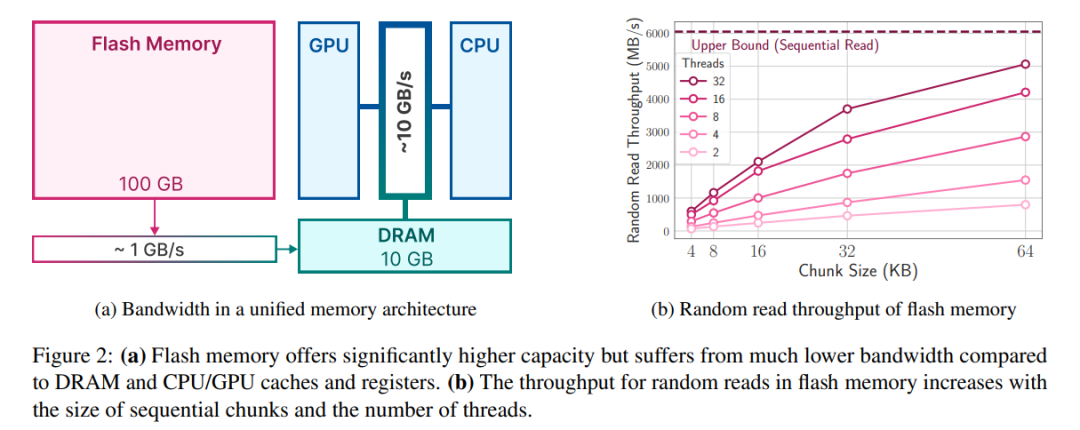
In scenarios where DRAM is sufficient, the cost of loading data is reduced, and the model can reside in DRAM. However, the initial loading of the model still consumes energy, especially if the first token requires fast response time. Our approach exploits activation sparsity in LLM to address these challenges by selectively reading model weights, thereby reducing time and energy costs.
Reexpressed as: Get data transfer rate
Flash systems perform best with large amounts of sequential reads. For example, the Apple MacBook Pro M2 is equipped with 2TB of flash memory, and in benchmark tests, the linear read speed of 1GiB of uncached files exceeded 6GiB/s. However, smaller random reads cannot achieve such high bandwidths due to the multi-stage nature of these reads, including the operating system, drivers, mid-range processors, and flash controllers. Each stage introduces latency, resulting in a larger impact on smaller read speeds
To circumvent these limitations, researchers advocate two main strategies, which can be used simultaneously.
The first strategy is to read larger data blocks. While the increase in throughput is not linear (larger data blocks require longer transfer times), the delay in initial bytes accounts for a smaller proportion of the total request time, making data reads more efficient. Figure 2b depicts this principle. A counter-intuitive but interesting observation is that in some cases, reading more data than needed (but in larger chunks) and then discarding it is faster than reading only what is needed but in smaller chunks .
The second strategy is to exploit the inherent parallelism of the storage stack and flash controller to achieve parallel reads. The results show that it is possible to achieve throughput suitable for sparse LLM inference using multi-threaded random reads of 32KiB or larger on standard hardware.
The key to maximizing throughput lies in how the weights are stored, as a layout that increases the average block length can significantly increase bandwidth. In some cases, it may be beneficial to read and subsequently discard excess data, rather than splitting the data into smaller, less efficient chunks.
Flash loading
Inspired by the above challenges, the researchers proposed a method to optimize the data transfer volume and improve the data transfer rate, which can be expressed as: To improve reasoning speed. This section discusses the challenges of performing inference on devices where the available computational memory is much smaller than the model size.
Analyzing this challenge requires storing complete model weights in flash memory. The primary metric used by researchers to evaluate various flash loading strategies is latency, which is divided into three different components: the I/O cost of performing the flash load, the memory overhead of managing the newly loaded data, and the computational cost of the inference operation.
Apple divides solutions for reducing latency under memory constraints into three strategic areas, each targeting a specific aspect of latency:
1. Reducing data load: Aiming to Load less data to reduce latency associated with flash I/O operations.
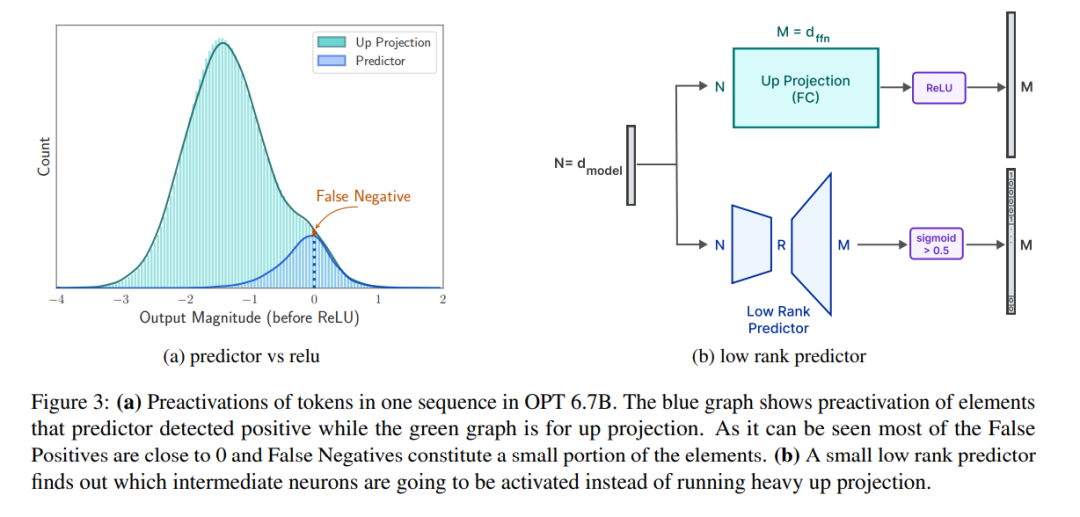
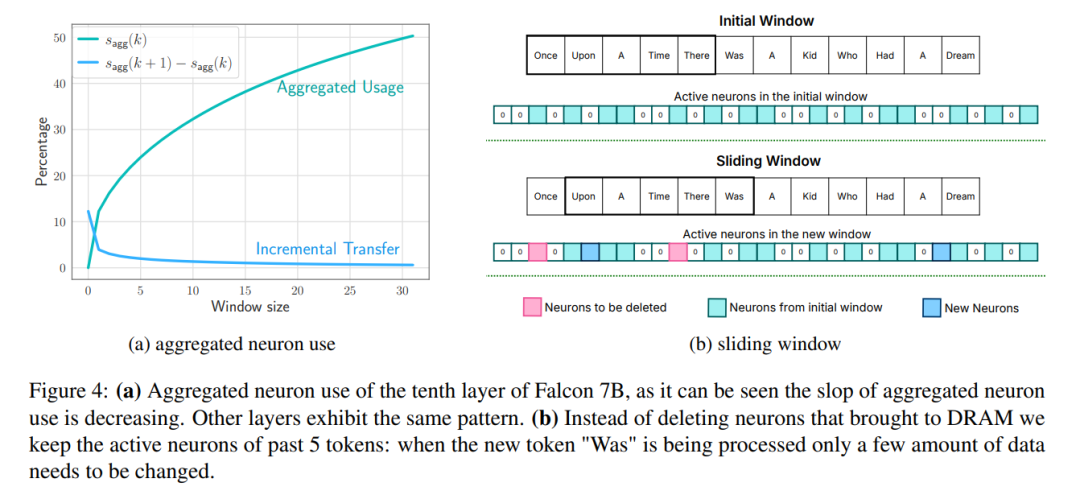
2. Optimize data block size: Improve flash throughput by increasing the size of the loaded data block, thereby reducing latency.
The following is the strategy used by researchers to increase data block size to improve flash read efficiency:
Bundle columns and rows
Co-activation-based bundling
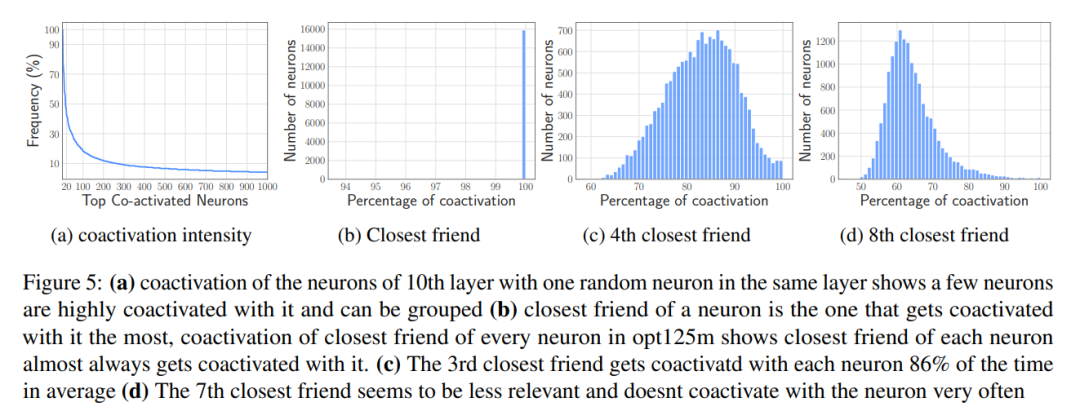
3. Effective management of loaded data: Simplify the management of data after it is loaded into memory to maximize Reduce expenses significantly.
Although transferring data in DRAM is more efficient than accessing flash memory, it incurs a non-negligible cost. When introducing data for new neurons, re-allocating matrices and adding new matrices can incur significant overhead due to the need to rewrite existing neuron data in DRAM. This is especially costly when a large portion (~25%) of the feedforward network (FFN) in DRAM needs to be rewritten.
In order to solve this problem, the researchers adopted another memory management strategy. This strategy involves pre-allocating all necessary memory and establishing corresponding data structures for efficient management. As shown in Figure 6, the data structure includes elements such as pointers, matrices, offsets, used numbers, and last_k_active
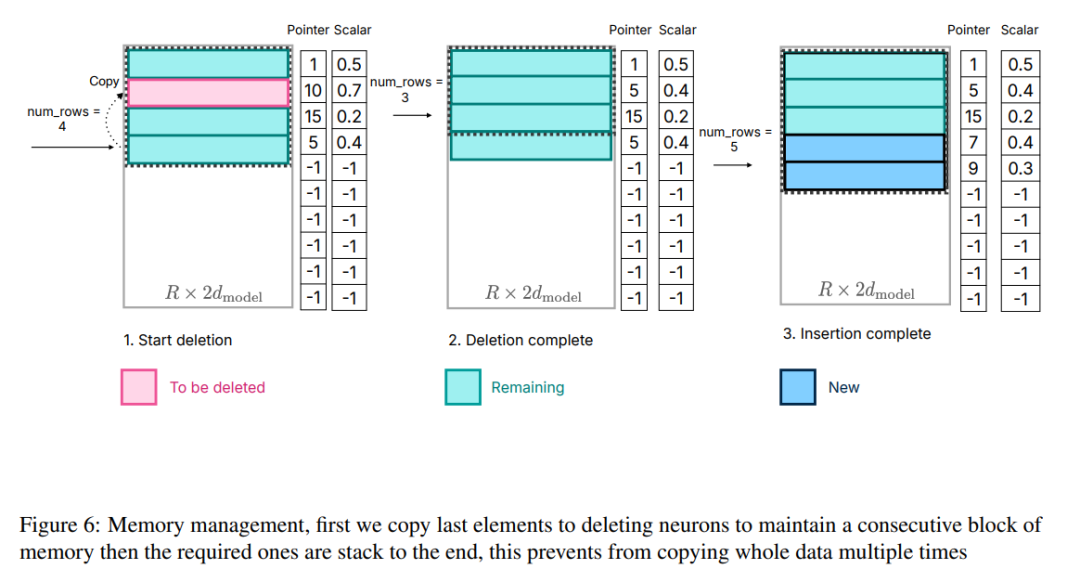
Figure 6: Memory Management , first copy the last element to the delete neuron to maintain the continuity of the memory block, and then stack the required elements to the end, which avoids copying the entire data multiple times.
It should be noted that the focus is not on the calculation process, because it has nothing to do with the core work of this article. This division allows researchers to focus on optimizing flash interaction and memory management to achieve efficient inference on memory-limited devices
requires rewriting of experimental results
OPT 6.7B Model Results
Predictor. As shown in Figure 3a, our predictor can accurately identify most activated neurons, but occasionally misidentifies non-activated neurons with values close to zero. It is worth noting that after these false negative neurons with close to zero values are eliminated, the final output result will not be significantly changed. Furthermore, as shown in Table 1, this level of prediction accuracy does not adversely affect the model's performance on the zero-shot task.
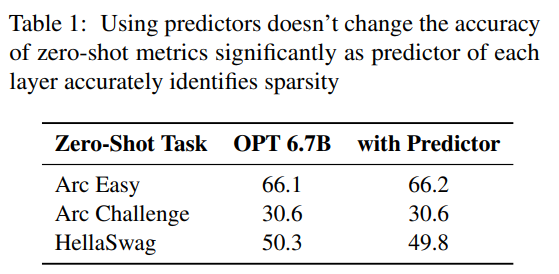
Delay analysis. When the window size is 5, each token needs to access 2.4% of the feedforward network (FFN) neurons. For the 32-bit model, the data block size per read is 2dmodel × 4 bytes = 32 KiB since it involves concatenation of rows and columns. On the M1 Max, the latency for flash loading per token is 125 milliseconds, and the latency for memory management (including deletion and addition of neurons) is 65 milliseconds. Therefore, the total memory-related latency is less than 190 milliseconds per token (see Figure 1). In comparison, the baseline approach requires loading 13.4GB of data at 6.1GB/s, resulting in a latency of approximately 2330 milliseconds per token. Therefore, our method is greatly improved compared to the baseline method.
For the 16-bit model on a GPU machine, flash load time is reduced to 40.5 milliseconds and memory management time is 40 milliseconds, with a slight increase in time due to the additional overhead of transferring data from the CPU to the GPU. Despite this, the I/O time of the baseline method is still over 2000 ms.
Table 2 provides a detailed comparison of the performance impact of each method.

Results for Falcon 7B model
Delay analysis. Using a window size of 4 in our model, each token needs to access 3.1% of the feedforward network (FFN) neurons. In the 32-bit model, this equates to a block size of 35.5 KiB per read (calculated as 2dmodel × 4 bytes). On an M1 Max device, flash loading this data takes about 161 milliseconds, and the memory management process adds another 90 milliseconds, so the total latency per token is 250 milliseconds. In comparison, with a baseline latency of about 2330 milliseconds, our method is approximately 9 to 10 times faster.
The above is the detailed content of Model inference acceleration: CPU performance is increased by 5 times. Apple uses flash memory for large-scale inference acceleration. Is Siri 2.0 about to debut?. For more information, please follow other related articles on the PHP Chinese website!

Hot AI Tools

Undresser.AI Undress
AI-powered app for creating realistic nude photos

AI Clothes Remover
Online AI tool for removing clothes from photos.

Undress AI Tool
Undress images for free

Clothoff.io
AI clothes remover

Video Face Swap
Swap faces in any video effortlessly with our completely free AI face swap tool!

Hot Article

Hot Tools

Notepad++7.3.1
Easy-to-use and free code editor

SublimeText3 Chinese version
Chinese version, very easy to use

Zend Studio 13.0.1
Powerful PHP integrated development environment

Dreamweaver CS6
Visual web development tools

SublimeText3 Mac version
God-level code editing software (SublimeText3)

Hot Topics
 1387
1387
 52
52
 The author of ControlNet has another hit! The whole process of generating a painting from a picture, earning 1.4k stars in two days
Jul 17, 2024 am 01:56 AM
The author of ControlNet has another hit! The whole process of generating a painting from a picture, earning 1.4k stars in two days
Jul 17, 2024 am 01:56 AM
It is also a Tusheng video, but PaintsUndo has taken a different route. ControlNet author LvminZhang started to live again! This time I aim at the field of painting. The new project PaintsUndo has received 1.4kstar (still rising crazily) not long after it was launched. Project address: https://github.com/lllyasviel/Paints-UNDO Through this project, the user inputs a static image, and PaintsUndo can automatically help you generate a video of the entire painting process, from line draft to finished product. follow. During the drawing process, the line changes are amazing. The final video result is very similar to the original image: Let’s take a look at a complete drawing.
 Topping the list of open source AI software engineers, UIUC's agent-less solution easily solves SWE-bench real programming problems
Jul 17, 2024 pm 10:02 PM
Topping the list of open source AI software engineers, UIUC's agent-less solution easily solves SWE-bench real programming problems
Jul 17, 2024 pm 10:02 PM
The AIxiv column is a column where this site publishes academic and technical content. In the past few years, the AIxiv column of this site has received more than 2,000 reports, covering top laboratories from major universities and companies around the world, effectively promoting academic exchanges and dissemination. If you have excellent work that you want to share, please feel free to contribute or contact us for reporting. Submission email: liyazhou@jiqizhixin.com; zhaoyunfeng@jiqizhixin.com The authors of this paper are all from the team of teacher Zhang Lingming at the University of Illinois at Urbana-Champaign (UIUC), including: Steven Code repair; Deng Yinlin, fourth-year doctoral student, researcher
 From RLHF to DPO to TDPO, large model alignment algorithms are already 'token-level'
Jun 24, 2024 pm 03:04 PM
From RLHF to DPO to TDPO, large model alignment algorithms are already 'token-level'
Jun 24, 2024 pm 03:04 PM
The AIxiv column is a column where this site publishes academic and technical content. In the past few years, the AIxiv column of this site has received more than 2,000 reports, covering top laboratories from major universities and companies around the world, effectively promoting academic exchanges and dissemination. If you have excellent work that you want to share, please feel free to contribute or contact us for reporting. Submission email: liyazhou@jiqizhixin.com; zhaoyunfeng@jiqizhixin.com In the development process of artificial intelligence, the control and guidance of large language models (LLM) has always been one of the core challenges, aiming to ensure that these models are both powerful and safe serve human society. Early efforts focused on reinforcement learning methods through human feedback (RL
 Posthumous work of the OpenAI Super Alignment Team: Two large models play a game, and the output becomes more understandable
Jul 19, 2024 am 01:29 AM
Posthumous work of the OpenAI Super Alignment Team: Two large models play a game, and the output becomes more understandable
Jul 19, 2024 am 01:29 AM
If the answer given by the AI model is incomprehensible at all, would you dare to use it? As machine learning systems are used in more important areas, it becomes increasingly important to demonstrate why we can trust their output, and when not to trust them. One possible way to gain trust in the output of a complex system is to require the system to produce an interpretation of its output that is readable to a human or another trusted system, that is, fully understandable to the point that any possible errors can be found. For example, to build trust in the judicial system, we require courts to provide clear and readable written opinions that explain and support their decisions. For large language models, we can also adopt a similar approach. However, when taking this approach, ensure that the language model generates
 A significant breakthrough in the Riemann Hypothesis! Tao Zhexuan strongly recommends new papers from MIT and Oxford, and the 37-year-old Fields Medal winner participated
Aug 05, 2024 pm 03:32 PM
A significant breakthrough in the Riemann Hypothesis! Tao Zhexuan strongly recommends new papers from MIT and Oxford, and the 37-year-old Fields Medal winner participated
Aug 05, 2024 pm 03:32 PM
Recently, the Riemann Hypothesis, known as one of the seven major problems of the millennium, has achieved a new breakthrough. The Riemann Hypothesis is a very important unsolved problem in mathematics, related to the precise properties of the distribution of prime numbers (primes are those numbers that are only divisible by 1 and themselves, and they play a fundamental role in number theory). In today's mathematical literature, there are more than a thousand mathematical propositions based on the establishment of the Riemann Hypothesis (or its generalized form). In other words, once the Riemann Hypothesis and its generalized form are proven, these more than a thousand propositions will be established as theorems, which will have a profound impact on the field of mathematics; and if the Riemann Hypothesis is proven wrong, then among these propositions part of it will also lose its effectiveness. New breakthrough comes from MIT mathematics professor Larry Guth and Oxford University
 arXiv papers can be posted as 'barrage', Stanford alphaXiv discussion platform is online, LeCun likes it
Aug 01, 2024 pm 05:18 PM
arXiv papers can be posted as 'barrage', Stanford alphaXiv discussion platform is online, LeCun likes it
Aug 01, 2024 pm 05:18 PM
cheers! What is it like when a paper discussion is down to words? Recently, students at Stanford University created alphaXiv, an open discussion forum for arXiv papers that allows questions and comments to be posted directly on any arXiv paper. Website link: https://alphaxiv.org/ In fact, there is no need to visit this website specifically. Just change arXiv in any URL to alphaXiv to directly open the corresponding paper on the alphaXiv forum: you can accurately locate the paragraphs in the paper, Sentence: In the discussion area on the right, users can post questions to ask the author about the ideas and details of the paper. For example, they can also comment on the content of the paper, such as: "Given to
 The first Mamba-based MLLM is here! Model weights, training code, etc. have all been open source
Jul 17, 2024 am 02:46 AM
The first Mamba-based MLLM is here! Model weights, training code, etc. have all been open source
Jul 17, 2024 am 02:46 AM
The AIxiv column is a column where this site publishes academic and technical content. In the past few years, the AIxiv column of this site has received more than 2,000 reports, covering top laboratories from major universities and companies around the world, effectively promoting academic exchanges and dissemination. If you have excellent work that you want to share, please feel free to contribute or contact us for reporting. Submission email: liyazhou@jiqizhixin.com; zhaoyunfeng@jiqizhixin.com. Introduction In recent years, the application of multimodal large language models (MLLM) in various fields has achieved remarkable success. However, as the basic model for many downstream tasks, current MLLM consists of the well-known Transformer network, which
 Axiomatic training allows LLM to learn causal reasoning: the 67 million parameter model is comparable to the trillion parameter level GPT-4
Jul 17, 2024 am 10:14 AM
Axiomatic training allows LLM to learn causal reasoning: the 67 million parameter model is comparable to the trillion parameter level GPT-4
Jul 17, 2024 am 10:14 AM
Show the causal chain to LLM and it learns the axioms. AI is already helping mathematicians and scientists conduct research. For example, the famous mathematician Terence Tao has repeatedly shared his research and exploration experience with the help of AI tools such as GPT. For AI to compete in these fields, strong and reliable causal reasoning capabilities are essential. The research to be introduced in this article found that a Transformer model trained on the demonstration of the causal transitivity axiom on small graphs can generalize to the transitive axiom on large graphs. In other words, if the Transformer learns to perform simple causal reasoning, it may be used for more complex causal reasoning. The axiomatic training framework proposed by the team is a new paradigm for learning causal reasoning based on passive data, with only demonstrations



